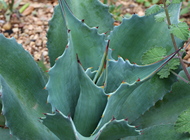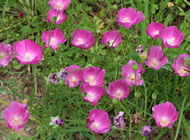 |
Adenophora liliifolia |
 |
Pretty bellflowers on upright stalks. Too bad the plant we obtained (from a reputable online nursery, too) turned out to want to conquer the world by root. It was almost certainly the evil Campanula rapunculoides – which I have still not eradicated from the areas of the garden where it managed to get a foothold. For the distinction between the genera, try this test, taken from the Gardens North website:
About 40 species of hardy, summer-blooming plants native to Eurasia and Japan, similar to Campanula because of their nodding, blue, bell-shaped flowers. For full sun or part shade in average garden soils. Adenophora and Campanula are often confused Here is a simple test for distinguishing the two. Take a flower and gently pull off the petals, leaving the style standing in the center. You will be left holding the base of the flower with a bumpy appendage (the ovary) in the middle and the style sticking straight up out of the center. VERY CAREFULLY peel off the outside of the bumpy appendage, leaving the style standing. If underneath, all you see is a flat base to which the style is attached, then you have a campanula. If, however, you see, after the peeling, another bulb-like appendage surrounding the style, then you have an adenophora. An easy way to rogue out all those imposters!
I had a quite useful email conversation with a fellow gardener who's been doing some research on plants masquerading as adenophoras in North America. He concluded (and I concur) that nearly all plants that are billed as adenophora around here are actually C. rapunculoides – which is not nearly as much the case in Europe. This is convincingly illustrated by the Google image searches for Adenophora liliifolia in Europe and Adenophora liliifolia in the US. The plants aren't very much alike at all – and yes, I still want the real thing.
|
This plant used to grow in our garden, but it slipped away... Read about my efforts to distinguish adenophoras from campanulas About my plant portraits
PlantLinks to other web pages about Adenophora liliifolia
Visitors to this page have left the following comments| anthony | Dec 29, 2005 | hi again..i had some ladybells in the ground in good ol' santa cruz, ca. this past year. a month after planting them they died, do the come back up in the springtime? or are they gone for good?..........is my question
I'm not the best source of information on gardening in mild climates. In my zone 6 garden, the ladybells die back in late fall, and return in spring. |
| Penny Baker | Jul 23, 2006 | No question, just thought you'd like to know, I found your information quite helpful to me in identifying a plant that showed up amongst some rasberry plants i transplanted. And they come back every year. I am in garden zone 1. Yes, that's right. I live in North Pole, Alaska. So, they will grow in cold climates and return. thank-you for your inforamtion. |
| mongobooo1313 | Jul 25, 2006 | Thank you sooo much for that fabulous picture of the Lady Bell (Adenophora lilifolia). I have this growing all over my yard (yes, it's trying to take over!), and thought at first it was Deadly Nightshade. Now I can stop pulling it all out, and let it do it's thing to fill in my puny garden!
Thanks again!
Wendy Miller
Tacoma, WA |
| AE | Jul 14, 2008 | I just bought an Adenophora "Amethyst". I live in Zone 5-6. Wondering if any body has info on it's performance in this zone. Will it come back?
thanks |
| Sandy | Aug 01, 2009 | I really don't remember purchasing and planting Adenophora lilifolia, but it is everywhere! I can't keep it out of my gardens, as it seems to invade everything. I have noticed it growing in the woods at least a quarter mile from our house, so I'm wondering if I did plant it years ago and forgot I did so and it spread that far, or if what's coming into my gardens is creeping in from the woods? Short of napalm, I guess it's here to stay. Much like the oregano I planted about 12 years ago. I'm sure it's already traveled to surrounding states.
I suspect that my plants were actually Campanula rapunculoides, and that you have the same thing. The true adenophora is reportedly not nearly as aggressive. |
| Bee | Jul 02, 2012 | Your diagnosis of Campanula rapunculoides is correct; IT is the agressive Kudzu-like perennial that takes over everything! It grows via tubers, seeds, and runners. The TRUE Adenophora sp. is NOT invasive!!! I recieved a plant 4 years ago and although tripling in size, it's still ONE plant...woe is me! This year, I'm going to save all the seeds and try to proprogate it that way; my lady-like Ladybells lives up to her name. :) |
| coriaceous | Apr 26, 2015 | Thank you for your dissections showing the difference between Adenophora and Campanula. It's finally cleared up a longstanding question I've had.
You're quite correct, the plant pictured above is C. rapunculoides. When I google "Adenophora liliifolia", the fourth hit is your picture of C. rapunculoides. I encourage you to move your picture to your entry for C. rapunculoides. There's enough confusion on the web about this already without your pic here adding to it.
I notice that the confusion is almost exclusively a North American phenomenon. I have a hard time finding a photograph claiming to show Adenophora liliifolia that looks remotely like C. rapunculoides if it's posted from elsewhere in the world.
Thanks for the nudge. I've removed the photo from this page. I still hope to grow the real thing one of these years... |
| B. Richards McIntyre | Jun 13, 2015 | This is a horrible weed here in Montana. The Campanula rapuculoides is, at any rate! Once it has established itself in one's yard or garden, beware! You'll never get rid of it. It spreads by deep, white roots resembling small parsnips or white carrots. Then it also sends out runners to establish even more plants besides producing copious amounts of seed. Grrrr! This plant is the plant that the fairy tale Rapunzel is based on. The real German fairy tale at any rate. The roots are indeed edible and actually delicious when prepared properly. Just don't steal the roots from a witches garden. They get very cantankerous and irritable if you do, hence the story of poor Rapunzel. |
- Seed from NARGS '08/'09 exchange, stored cold over summer. Baggy 35F (100%G, 3-4w)
I welcome comments about my web pages; feel free to use the form below to
leave feedback about this particular page. For the benefit of other visitors
to these pages, I will list any relevant comments you leave, and if
appropriate, I will update my page to correct mis-information. Faced with an
ever-increasing onslaught of spam, I'm forced to discard any comments including
html markups. Please submit your comment as plain text. If you have a
comment about the website as a whole, please leave it in my
guestbook. If you
have a question that needs a personal response, please
e-mail me.
common mis-spellings: lilifolia
Last modified:
June 30, 2016
Contact me
|


